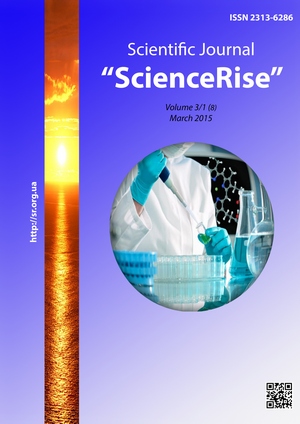Immunogenetic analysis of hybrid populations of the green frog complex pelophylax esculentus-ridibundus of the fauna of Ukraine
DOI:
https://doi.org/10.15587/2313-8416.2015.39370Keywords:
гібридний комплекс Pelophylax esculentus-ridibundus, імуногенетичні дослідження, ало-, ксенотрансплантаціяAbstract
For purposes of unravelling the development of the hybrid complex Pelophylax esculentus-ridibundus an immunogenetic method of skin transplantation was applied for assessing the variability of hybrids and parental species according to levels of expressed histocompatability. Animals from the different types of hybrid systems known in Ukraine were studied. For allodiploid hybrids dominance of genes of major histocompatibility complex of frog edible was established
References
Berger, L. (1983). Western Palearctic water frogs (Amphibia, Ranidae): systematics, genetics and population compositions. Experientia, 39 (2), 127–130. doi: 10.1007/bf01958859
Tunner, H. G. (1974). Die klonale Struktur einer Wasserfrosch population. Journal of Zoological Systematics and Evolutionary Research, 12 (4), 309–314. doi: 10.1111/j.1439-0469.1974.tb00173.x
Günther, R. (1970). Der Karyotyp von Rana ridibunda Pall. und das Vorkommen von Triploidie bei Rana esculenta L. (Anura, Amphibia). Biologisches Zentralblatt. 89 (3), 327– 342.
Tunner, H. G. (1974). Die klonale Struktur einer Wasserfrosch population. Zeitschrift für zoologische Systematik und Evolutionsforschung, 12 (4), 309–314. doi: 10.1111/j.1439-0469.1974.tb00173.x
Graf, J.-D., Polls-Pelaz, M. P. (1989). Cytogenetic analysis of spermatogenesis in unisexual allotriploid males from a Rana lessonae - Rana kl. esculenta mixed population. First World Congress of Herpetology. University of Kent Canterbury, 124–136.
Nekrasova, O. D. (2002). Struktura populyatsiy i gibridizatsiya zelenyih lyagushek (Rana esculenta complex) urbanizirovannyih territoriy Srednego Pridneprovya:[ Population structure and hybridization green frogs (Rana esculenta complex) urbanized areas of the Middle Dnieper]. Institute of zoology, Ukrainian Academy of Sciences. Kiev, 19.
Berger, L., Uzzell, T., Hotz, H. (1988). Sex determination and sex ratios in western Palearctic water frogs: XX and XY female hybrids in the Pannonian Basin? Proceedings of the Academy of Natural Sciences of Philadelphia, 140 (1), 220–239.
Berger, L. (1990). On the origin of genetic systems in European water frog hybrids. Zoologica Poloniae, 35 (1-4), 5–32.
Vinogradov, A. E., Borkin, L. J., Günther, R., Rosanov, J. M. (1991). Two germ cell lineages with genomes of different species in one and the same animal. Hereditas, 114, 245–251. doi: 10.1111/j.1601-5223.1991.tb00331.x
Mezhzherin, S. V., Morozov-Leonov, S. Yu. (1993). Populyatsionno-geneticheskiy analiz strukturyi gibridnyih populyatsiy Rana esculenta complex [Population genetic analysis of the structure of hybrid populations of Rana esculenta complex]. Tsitologiya i genetika, 27 (2), 63–68.
Morozov-Leonov, S. Yu. (2014). Gibridizatsiya amfibiy: struktura populyatsiy, evolyutsiyni naslidki, status gibridnih biotipiv. [Hybridization of amphibians: the structure of populations, evolutionary consequences, the status of hybrid biotypes]. Institute of zoology, Ukrainian Academy of Sciences. Kiev, 36.
Cohen, N. (1971). Amphibian Transplantation Reactions: A Review. Integrative and Comparative Biology, 11 (2), 193–205. doi: 10.1093/icb/11.2.193
Płytycz, B. (1984). Differential polymorphism of the amphibian MHC. Developmental & Comparative Immunology, 8 (3), 727–732. doi: 10.1016/0145-305x(84)90104-6
Płytycz, B., Semik, D. (1980). Rejection of skin allo- and xenografts in the grass frog, Rana temporaria and the edible frog, Rana esculenta. Archivum immunologiae et therapiae experimentalis, 28, 625–634.
Kozinenko, I. I., Zhalay, E. I., Zavodnikova, N. S. (2006). Osobennosti allotransplantatsii v gibridnom komplekse zelenyih lyagushek Rana esculenta. [Features allotransplantation in the hybrid complex of green frog Rana esculenta]. Vestnik zoologii, 40 (1), 49–53.
Mezhzherin, S. V., Morozov-Leonov, S. Yu. (1997). Diffuzii genov v gibridnyih populyatsiyah zelenyih lyagushek Rana esculenta L., 1758 complex (Amphibia, Ranidae) Pridneprovya [Diffusion of genes in hybrid populations of green frogs Rana esculenta L., 1758 complex (Amphibia, Ranidae) Pridneprovya]. Genetika, 33 (3), 358–364.
Zhalay, O. I., Kozinenko, I. I. (2005). Analiz odnostatevoyi gibridnoyi populyatsiyi zhab Rana esculenta complex Zakarpattya metodom transplantatsiyi shkiri [Analysis of unisexual hybrid populations frog Rana esculenta complex Transcarpathia by transplantation of skin]. Nauk. visnik Uzhgorodskogo universitetu. Seriya Biologiya, 16, 176–179.
Semik, D. (1983). Comparison of reactions to skin grafts in green frogs: Rana lessonae Cam., R. esculenta L. and R. ridibunda Pall. Archivum immunologiae et therapiae experimentalis, 31, 429–436.
Terentev, P. V. (1943) Korrelyatsii indeksov ozernoy lyagushki Rana ridibunda Pall. [Correlation indices lake frog Rana ridibunda Pall]. Zool. zhurnal., 43 (3), 175–181.
Berger, L. (1976). Yavlyaetsya li prudovaya lyagushka Rana esculenta complex obyiknovennyim gibridom? [Is the pond frog Rana esculenta complex ordinary hybrid?]. Ekologiya, 2, 37–43.
Downloads
Published
Issue
Section
License
Copyright (c) 2015 Iryna Kozynenko, Elena Zhalai

This work is licensed under a Creative Commons Attribution 4.0 International License.
Our journal abides by the Creative Commons CC BY copyright rights and permissions for open access journals.
Authors, who are published in this journal, agree to the following conditions:
1. The authors reserve the right to authorship of the work and pass the first publication right of this work to the journal under the terms of a Creative Commons CC BY, which allows others to freely distribute the published research with the obligatory reference to the authors of the original work and the first publication of the work in this journal.
2. The authors have the right to conclude separate supplement agreements that relate to non-exclusive work distribution in the form in which it has been published by the journal (for example, to upload the work to the online storage of the journal or publish it as part of a monograph), provided that the reference to the first publication of the work in this journal is included.

